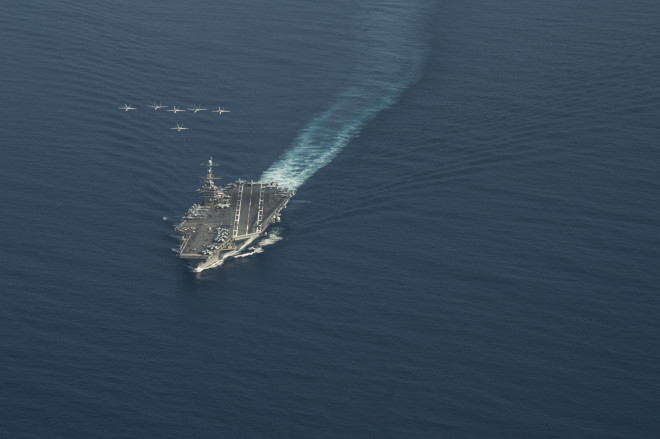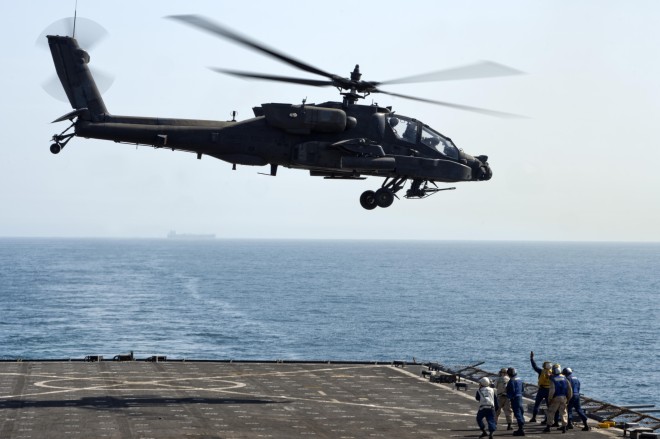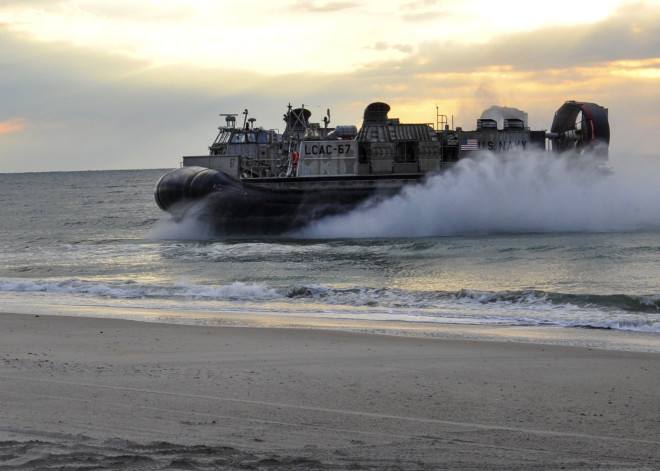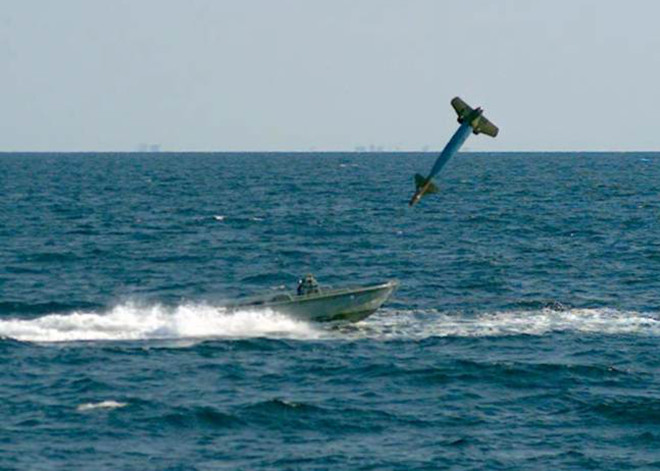
The Pentagon is taking its next steps in developing the often misunderstood and occasionally controversial Air-Sea Battle concept, according to several USNI News interviews with Navy and defense officials.
The effort is the latest from the Air-Sea Battle Office (ASBO), a group of 20-some military intellectuals who have been struggling on how to counter what the Pentagon sees as its toughest problems in the wake of more than a decade of low-intensity ground conflicts: anti-access/area-denial (A2/AD) strategies.
A2/AD is an age-old strategy that stiff-arms a military force, preventing opponents from accessing a physical position on the sea, land or the air.
For a time, for example, the Great Wall of China denied the Mongol hordes access to China’s interior. Likewise, minefields prevent an infantry unit from operating on a particular piece of land. Anti-air missiles prevent fighters and bombers from striking more difficult targets in a protected area.
Typically the strategy was—and is—used by an inferior military to contain a larger, more sophisticated force, and blunt its attacking power.
As the United States was focused on Iraq and Afghanistan, threats to U.S. abilities to operate freely with its military have increased—such as cheaper longer-range guided missiles—making it harder for U.S. forces to access areas in which they would like to operate.
A global rise in sophisticated weapons technology, combined with the U.S. focus on the ground wars of Afghanistan and Iraq, has allowed American proficiency in countering A2/AD threats to slip.
“We’ve lost some skills and let them wither, because it wasn’t required in operations in the past,” one defense official told USNI News.
Enter ASBO.

At its onset the Air-Sea Battle Office was tasked with taking knowledge from the Navy, Army, Marine Corps and Air Force, understanding with exhaustive detail the tactics and equipment the services used to handle A2/AD threats, and then providing commanders on the ground with solutions to solve the problem using the material they had on hand.
The goal is for the U.S. military to, “go into an area, [and when] someone throws up jammers, somebody throws out mines, somebody throws out submarines as a threat to your surface ships . . . you know right away what to do about it,” Rear Adm. James Foggo, the Navy’s head of operations, plans and strategy told USNI News earlier this month.
At the beginning, the ASBO acted like a help desk for the A2/AD fight. Commanders would initially reach out to the office and the ASBO would give them options on how to use their existing equipment to deal with anti-access threats.
“The beauty of the concept is it focuses the services on what the problems are. That’s become a very useful lens,” a defense official familiar with the ASBO told USNI News. “It’s the disrupt, destroy and defeat approach that Air Sea battle embraces that talks about a different way of waging war. It applies an operational design on how you would do that against an adversary that [has] multiple types of these capabilities.”
The early help-desk approach has evolved into a more sophisticated set of goals, outlined in the ten mission areas where the United States needs in improve.
These areas—ranging from how to protect assets in space to waging war at sea—all point to capabilities the military has let atrophy while the focus was on the largely low intensity occupations of Iraq and Afghanistan, one defense official told USNI News. “It was the outside-the-Pentagon folks who guided us to these ten mission focus areas,” a defense official told USNI News. “We’re talking to the fleets and forces and they’re helping us rationalize our priorities.”

Pentagon officials provided USNI News a list of the ten areas the ASBO singled out for additional work:
Cross-Domain Operations Command-and-Control (C2)
A fundamental task of any military is telling forces where to go and what to do when they get there. In ASB, the challenge is to efficiently coordinate air, land and sea forces together effectively where seconds count. The Pentagon has several systems in place to undertake the C2 role. An ASB challenge would be to integrate the systems, which do not all communicate with each other.
Undersea Warfare Supremacy
Submarines are a powerful weapon in denying an adversary access in the ocean. Several countries in Southeast Asia have been buying quiet diesel-electric submarines best suited for short-range patrols close to shore. U.S. nuclear submarines can better project power far from shore and the in open ocean, but likely are louder than their diesel-electric counterparts. The area also implies the United States could do more in the anti-submarine warfare realm in detecting an adversary’s submarines before they can do damage to the Navy’s forces.
War at Sea
The U.S. Navy has focused its surface fleet on anti-air warfare and ballistic missile defense roles with its Aegis cruisers and destroyers. Additionally, the Navy’s new littoral combat ships are more oriented toward operations closer to shore. Open-ocean and ship-to-ship warfare has not been a priority for the Navy for years; there has been little development in modern anti-ship weapons. The Pentagon has only recently launched the Long-Range Anti-Ship Missile program to counter some the newer threats. Iran, China and Russia have heavily invested in ships having the primary function of fighting other ships.
Attack Operations to Defeat A2/AD
Attacking elements of an A2/AD strategy to prepare for a larger follow-on force. This could include using a combination of penetrating strike assets, such as a long-range U.S. Air Force stealth bomber or fifth-generation fighter alongside cruise missiles, electronic attacks and cyber-warfare to target the means by which the enemy is conducting its A2/AD strategy. This could mean attacking command-and-control nodes, eliminating surface-to-air missile batteries and coastal defenses or even knocking out launch sites for the so called “carrier killer” missiles or even disrupting enemy infrastructure by hacking their electrical grids.
Active and Passive Defense
Active defense uses military power to deny an enemy a specific piece of territory by physically attacking potential threats before it can launch its weapons. One example would be to sink an enemy submarine before got into position to launch its cruise missiles. Passive defense is designed to resist attacks in a specific area by hardening, camouflaging or dispensing forces and could mean intercepting incoming enemy weapons. The Air-Sea Battle concept would integrate the separate systems the services use already to execute both.
Distributed Basing
Instead of operating from a large single land base, distributed basing spreads out a force across several different semi-prepared positions making it harder for an adversary to target. As the United States consolidates its bases in the Pacific, it has explored operating from other bases in the event of a conflict. For example, the United States could be using airstrips in the Philippines for military aircraft. Potentially, entirely new airstrips could be cleared out for temporary use as needed—as was the case during World War II.
Contested Space Operations
Securing U.S. assets in space, such as satellites. Ship-based missiles have been able to successfully shoot down satellites in the past. But this does not necessarily require armoring up satellites or that space vehicles need to maneuver to avoid threats; it could simply mean securing against the jamming of satellite communications or GPS signals. Additionally it could entail securing U.S. satellite ground stations from physical or cyber attack, which for an enemy are easier options than a physical attack on an orbiting satellite. Or, on the other side of the spectrum, it could mean attacking enemy satellites, their signals, or ground stations either by kinetic or electronic means.
Contested Intelligence, Surveillance and Reconnaissance (ISR)
How to provide forces the information they need to operate and make battlefield and strategic decisions in combat. Most current U.S. ISR platforms are designed for operations in permissive environments, but in an A2/AD environment, the enemy will fight to prevent U.S. forces from conducting surveillance. That means assets that are useful in places such as Iraq and Afghanistan—a Predator or Reaper—may not be useful over Iran or China because both states have the means to shoot them down. ISR data will therefore have to be gathered by penetrating stealth platforms: fifth-generation fighters, the USAF’s future LRS-B, or some sort of low-observable unmanned aircraft. Other options include using space or cyber assets. Another pressing concern in a communications degraded/denied environment is getting the data back to analysts so it may be processed—which may not be an easy task. That data will also have to be analyzed without overburdening intelligence personnel, as was the case over the past 10 years.
Contested Logistics and Sustainment
This area deals with establishing and defending supply lines during a conflict. Given the distances American forces operate from U.S. shores, logistics can an Achilles’ heel. A smart enemy will attack the logistical train that keeps U.S. forces at the front line going—via any number of methods, ranging from kinetic attacks on port facilities and airstrips to cyber attacks on DOD computers.
Contested Cyberspace Operations
Cyber warfare is the least transparent of military operations. The bulk of cyber is maintaining and securing existing communications networks. Offensive cyber operations—exploiting enemy computer networks to gain an equivalent affect from a so-called kinetic weapon—are closely guarded by the military. But cyber can also be used as means of gathering intelligence or feeding disinformation to the enemy. Without doubt, cyber will be one of the most important “battlefields” in future warfare, as U.S. forces are entirely dependent on networks to conduct operations.
Next Steps

The feedback from the ten mission areas —as part an “implementation master plan”—will get further evaluation in November, Foggo told USNI News.
The office will then, “bring individuals into D.C. as representatives of the combatant commands, the numbered fleets and the numbered air forces and sit down at the table and say, ‘Let’s put all this stuff out here on how we collate, how do we bring this together, how do we distribute and disseminate,’” Foggo said.
Primarily the interactions just now are not with the Pentagon’s combatant commanders, but to service offices that provide forces to the regional commands around the world. It’s up to those commands to decide which of the ten areas are the highest priority.
“They are not prioritized on purpose. We don’t see that as our role. That’s for them—the ones out in the field—to prioritize,” Foggo said.
“It’s going to vary by geographic location. Say you’re the [Central Command], you think about the Arabian Gulf and the Strait of Hormuz, what’s the most important thing? Maintaining access in the Strait of Hormuz. What’s the easiest way to shut it down? Clandestinely—probably with mines. Your priority in mine warfare might be higher than [Africa Command] commander’s priority or the [European Command] commander’s priority. It depends what the COMCOM is looking at.”
The hope for the Pentagon and the services is the ASBO will be able to improve skills and techniques in a low-cost method. As the office interacts with the services the best practices across the services will trickle down to the way they buy equipment and create and improve doctrine through a continued series of plans.
“It’s a living and breathing and evolving thing. This year the implementation will be ready in 2014, there will be another one the next year,” Foggo said. “The joint force has come together on how to operate in an anti-access environment so it’s just seamless.”




